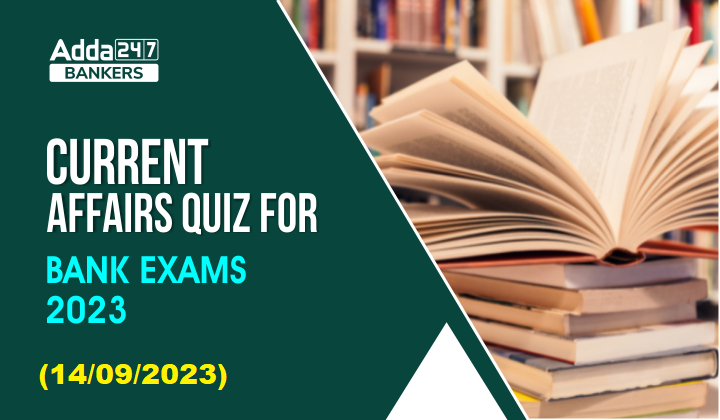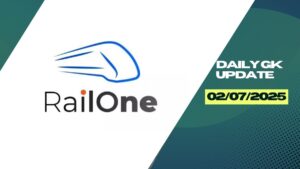14 September 2023 Current Affairs Questions And Answers: Here, we are providing the Current Affairs Questions and Answers for 14 September 2023. These types of topics are important for candidates who prepare for Bank Exam 2023. In this article, we are covering the following topics Headlines:
- India’s retail inflation rate in August
- India’s industrial output (IIP)
- OTG Ring
- National Payments Corporation of India
- Cashfree Payments’ ‘AutoPay on QR’
- Gender Snapshot 2023 report
14th September Current Affairs 2023 Quiz
The Current Affairs 2023 section constitutes a major part of the General Awareness section in a competitive examination and plays an instrumental role. To supplement your preparation for the General Awareness Section of the upcoming exams like IBPS PO/Clerk Mains, SBI PO Mains and SEBI Grade A Prelims, we are providing you 14th September Current Affairs 2023 Quiz covering the following topics Headlines: India’s retail inflation rate in August, India’s industrial output (IIP), OTG Ring, National Payments Corporation of India, Cashfree Payments’ ‘AutoPay on QR’, Gender Snapshot 2023 report.
Q1. What is the inflation target set by the RBI for the current financial year?
(a) 2%
(b) 3%
(c) 4%
(d) 5%
(e) 6%
Q2. What was India’s retail inflation rate in August 2023?
(a) 5.4%
(b) 6.83%
(c) 7.44%
(d) 6.0%
(e) 8.0%
Q3. How did India’s industrial output (IIP) perform in July 2023?
(a) It declined by 3.8%
(b) It remained unchanged
(c) It grew at 5.7%
(d) It grew at 5.0%
(e) It grew at 8.0%
Q4. What did the Reserve Bank of India (RBI) state in response to the rising inflation?
(a) It will lower interest rates immediately.
(b) It will take no action.
(c) It will raise interest rates if conditions require.
(d) It will introduce new currency notes.
(e) It will reduce the fiscal deficit.
Q5. Which of the following is not a key feature of the OTG Ring, launched by NPCI?
(a) It is a contactless payment wearable ring.
(b) It is designed and made in India.
(c) It is compatible with various open-loop transit programs.
(d) It can be used to make payments at merchant outlets.
(e) It can be used to withdraw cash from ATMs.
Q6. The New Development Bank (NDB) was established by which group of countries?
(a) G7
(b) ASEAN
(c) BRICS
(d) NAFTA
(e) SAARC
Q7. Which of the following organizations is not involved in the development of the OTG Ring?
(a) NPCI
(b) LivQuik
(c) National Common Mobility Card (NCMC)
(d) Indian Highway Management Company Limited (IHMCL)
(e) State Bank of India (SBI)
Q8. Which of the following is not a feature of Cashfree Payments’ ‘AutoPay on QR’?
(a) It simplifies the process of mandate creation for subscription services.
(b) It can be integrated across marketing channels.
(c) It eliminates the need to download an app or register on a website.
(d) It can be used to pay for goods and services.
(e) It is a payment gateway solution.
Q9. Which of the following is not a key finding of the Gender Snapshot 2023 report?
(a) Progress towards achieving gender equality is significantly on track.
(b) Deeply entrenched biases against women threaten to derail this ambitious goal.
(c) Active resistance to gender equality and chronic underinvestment are pivotal roadblocks.
(d) The report estimates the need for $6.4 trillion annually in 48 developing countries to achieve gender equality across various key areas by 2030.
(e) The labor and earnings gap between men and women remains stubbornly high, with women earning only 51 cents for every dollar earned by men.
Q10. According to the Fiscal Health Report, which states are identified as most vulnerable to debt sustainability risks?
(a) Punjab, Bihar, and Rajasthan
(b) Kerala, Tamil Nadu, and Maharashtra
(c) Gujarat, Uttar Pradesh, and Madhya Pradesh
(d) Karnataka, Haryana, and Odisha
(e) Maharashtra, Chhattisgarh, and West Bengal
Q11. What impact does the expected nominal GDP growth rate for the current year have on states’ debt/GSDP ratio?
(a) It will decrease the ratio significantly.
(b) It will have no impact on the ratio.
(c) It might lead to a lower debt/GSDP ratio.
(d) It could result in a higher debt/GSDP ratio.
(e) It will cause the ratio to fluctuate unpredictably.
Q12. When does the windfall profit tax come into effect?
(a) On a monthly basis.
(b) When global oil prices drop below a certain threshold.
(c) When crude oil production exceeds a certain limit.
(d) When the difference between crude oil and petroleum product prices is high.
(e) On August 15 each year.
Q13. Which of the following is not a category of investments under the RBI’s new directives?
(a) Held to Maturity (HTM)
(b) Available for Sale (AFS)
(c) Fair Value through Profit and Loss (FVTPL)
(d) Non-SLR securities
(e) Preference shares
Q14. Which of the following securities can be classified as HTM under the RBI’s new directives?
(a) Government securities
(b) Treasury bills
(c) Certificates of deposit
(d) Commercial paper
(e) All of the above
Q15. Which of the following is NOT an initiative taken by the Ministry of Cooperation to strengthen Primary Cooperatives (PACS)?
(a) Formation of new Farmer Producer Organization (FPOs) by PACS.
(b) PACS eligible for LPG Distributorship for diversifying its activities.
(c) Convergence of PM-KUSUM at PACS level for energy security.
(d) Rupay Kisan Credit Card to Members of Milk Cooperatives.
(e) All of the above are initiatives taken by the Ministry of Cooperation.
Solutions
S1. Ans.(c)
Sol. The inflation target set by the RBI for the current financial year (2023-24) is 4% with a tolerance band of +/- 2%. This means that the RBI will aim to keep inflation between 2% and 6%.
S2. Ans.(b)
Sol. In August 2023, India’s retail inflation, as measured by the Consumer Price Index (CPI), stood at 6.83%. This figure represents the percentage increase in the general price level of consumer goods and services compared to the previous year. It indicates the overall rise in the cost of living for consumers during that period.
S3. Ans.(c)
Sol. India’s industrial output, as measured by the Index of Industrial Production (IIP), showed positive growth of 5.7% in July 2023. This indicates that the country’s industrial sector expanded during that month, which can be a sign of economic activity and production picking up.
S4. Ans.(c)
Sol. The RBI stated that it would be ready to take action, including raising interest rates, if conditions warrant such measures in response to the rising inflation.
S5. Ans.(e)
Sol. The OTG Ring is a contactless payment wearable ring. It can be used to make payments at merchant outlets and to access open-loop transit programs. However, it cannot be used to withdraw cash from ATMs.
S6. Ans.(c)
Sol. The New Development Bank (NDB) is a multilateral development institution established by Brazil, Russia, India, China, and South Africa (BRICS) to finance sustainable development projects in emerging economies.
S7. Ans.(e)
Sol. The OTG Ring has been developed by NPCI in collaboration with LivQuik. NCMC is a critical component of India’s digital payments ecosystem and will be compatible with the OTG Ring. IHMCL is a strategic partner of NPCI and has partnered with NPCI to introduce EV charging payments on the National Electronic Toll Collection (NETC) FASTag platform. However, SBI is not involved in the development of the OTG Ring.
S8. Ans.(e)
Sol. Cashfree Payments’ ‘AutoPay on QR’ is a subscription management solution, not a payment gateway solution. It helps businesses to automate the subscription process for their customers.
S9. Ans.(a)
Sol. The Gender Snapshot 2023 report clearly states that progress towards achieving gender equality is significantly off track.
S10. Ans.(a)
Sol. Punjab, Bihar, and Rajasthan. These states are highlighted as vulnerable due to weak fiscal and debt metrics even before the pandemic, as mentioned in the report.
S11. Ans.(d)
Sol. The report indicates that despite recent double-digit nominal GDP growth, the anticipated growth for the current year might not be as high, which could impact the debt/GSDP ratio of states.
S12. Ans.(b)
Sol. The windfall profit tax is triggered when global benchmark oil prices rise above a certain threshold, usually $75 per barrel.
S13. Ans.(d)
Sol. The RBI’s new directives classify investments into three main categories: HTM, AFS, and FVTPL. Non-SLR securities are not a separate category of investments under the new directives. They can be classified as HTM, AFS, or FVTPL depending on the bank’s intention and the characteristics of the security.
S14. Ans.(e)
Sol. The RBI’s new directives allow banks to classify government securities, treasury bills, certificates of deposit, and commercial paper as HTM. These securities are all considered to be of high quality and have a low risk of default.
S15. Ans.(e)
Sol. Each of the mentioned initiatives (a to d) is a step taken by the Ministry to strengthen Primary Cooperatives (PACS). These initiatives aim to make PACS more transparent, economically vibrant, and multipurpose entities, diversifying their activities and improving their access to various services.
14th September 2023 Current Affairs Quiz: Download PDF
You may also like to read:
- Current Affairs & Daily GK Updates 2023
- Latest GK and Current Affairs Questions With Answers For All Bank Exam




 Daily Current Affairs 4th July 2025, Imp...
Daily Current Affairs 4th July 2025, Imp...
 Daily Current Affairs 3rd July 2025, Imp...
Daily Current Affairs 3rd July 2025, Imp...
 Daily Current Affairs 2nd July 2025, Imp...
Daily Current Affairs 2nd July 2025, Imp...


